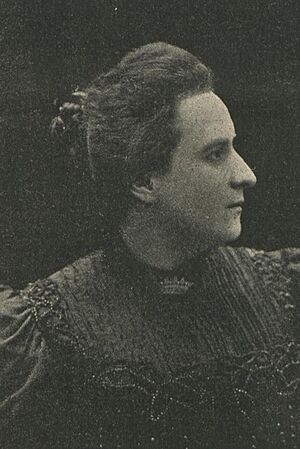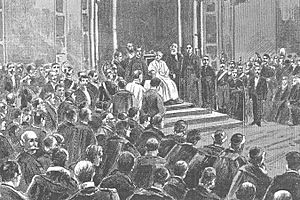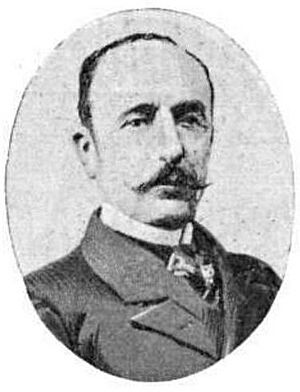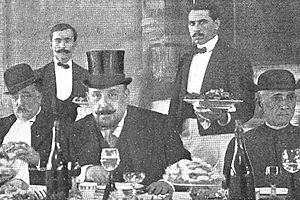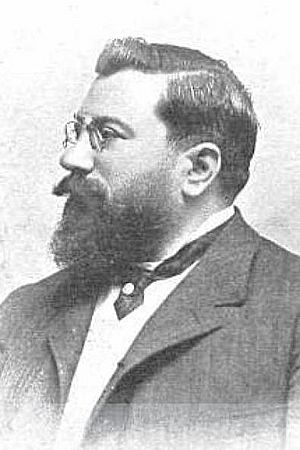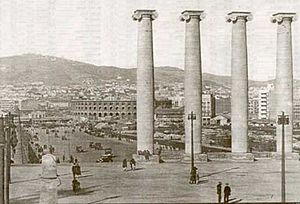Manuel de Llanza y Pignatelli facts for kids
Quick facts for kids
Manuel de Llanza y Pignatelli
|
|
|---|---|
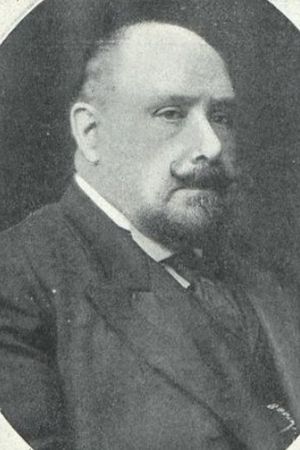 |
|
| Born |
Manuel de Llanza y Pignatelli
1858 |
| Died | 1927 Barcelona
|
| Nationality | Spanish |
| Occupation | Landowner |
| Known for | politician |
| Political party | Carlism |
| Signature | |
Manuel de Llanza y de Pignatelli de Aragón (1858–1927) was an important Spanish politician from the Carlism movement. He held several noble titles, including the 9th Duke of Solferino. In the late 1800s, he became a key leader for the Carlist party in Catalonia, a region in Spain. He was the regional leader (called "jefe") twice, from 1910 to 1914 and again from 1917 to 1919. Manuel de Llanza is known as a typical example of a noble person who helped lead the Carlist party during a time in Spanish history called the Restoration period.
Contents
Family Background
The Llanza family is one of the oldest in Catalonia, with records going back to the 1100s. Manuel's grandfather, Rafael de Llanza i de Valls (1772–1833), had an exciting military career. He fought in many wars across Europe, sometimes against the French, and sometimes with them. His personal diary gives us a look into the lives of Spanish soldiers during the invasion of Russia.
Manuel's father, Benito Llanza y de Esquivel (1822–1863), was a high-ranking official in the Ministry of Public Education. He was also a respected intellectual in Barcelona. In 1849, he married Maria de la Concepción Pignatelli de Aragón y Belloni (1824-1858). She was the Duchess of Solferino and inherited a huge amount of land in Aragon.
Manuel was the younger of two sons. Sadly, both his parents died when he was very young. His older brother also died as a baby, so Manuel inherited all the family's noble titles and wealth at just 10 years old. He and his sisters were raised by their uncle, Rafael Llanza y Esquivel, who was a strong supporter of Carlism.
The family left Spain when the Republic was declared and returned in 1876. Manuel then studied law at Universidad de Barcelona. In 1881, he married Maria Asunción de Bobadilla y Martínez de Arizala (1861-1898). Her father was a leader of Carlism in Navarre. Manuel and Maria had seven children. Their oldest son, Luis Gonzaga de Llanza y de Bobadilla, later inherited the ducal title.
Early Political Life
As a "grandee of Spain" (a very high noble title), Manuel de Llanza was welcomed into the Carlist movement. The Carlists were a political group who supported a different branch of the Spanish royal family. After a military defeat in 1876, the Carlist party was led by Cándido Nocedal. He focused the party on religious activities to keep people involved.
One important part of this strategy was organizing large religious trips, called pilgrimages. Manuel de Llanza took part in the first big pilgrimage to Rome in 1876. He also joined the next one in 1878. By 1881, he became one of the organizers for future pilgrimages.
Throughout the 1880s, Manuel was very active in these religious trips. He helped arrange pilgrimages to important places like Montserrat in Catalonia and Lourdes in France. He also became the president of the "Juventud Católica" (Catholic Youth) organization in Catalonia. He donated money to Catholic causes and hosted bishops at his home.
Manuel de Llanza was also involved in Carlist projects, like building a monument to a Carlist hero. Even the local government recognized his organizing skills. In 1887, the mayor of Barcelona asked him to join a group that coordinated charity work.
There was a disagreement within the Carlist party. Manuel de Llanza was seen as a supporter of a group called the "Integrists." However, he chose to stay loyal to the Carlist claimant, Carlos VII, who was the person they believed should be king.
Member of Parliament and Senator
After some members left the Carlist party, the new leader, Marqués de Cerralbo, worked to build up the party's organization. Manuel de Llanza became the Carlist leader for the Aragon region. This also made him part of the party's main national committee.
In 1890, Manuel de Llanza ran for election to the Spanish Parliament (called the Cortes). He ran in Vich, Catalonia, and Huesca, Aragon, where he owned a lot of land. He won in Vich in 1892.
Because he was a grandee of Spain, Manuel de Llanza had the right to join the Senate when he turned 35. So, in 1893, he became a senator. He was one of only two Carlists in the Senate at that time. He continued to be involved in religious pilgrimages and worked with other Carlist leaders to develop Traditionalist newspapers.
In 1896, Manuel de Llanza and other Carlist politicians left the Cortes. They said that the political system was corrupt. His involvement in some small Carlist revolts in Catalonia in 1900 is not clear. Police searched his Barcelona palace and reportedly found some rifles. He denied being involved, but he was briefly held by the police in 1901.
Solidaritat Catalana
In the early 1900s, Manuel de Llanza was considered one of the most important Carlist leaders in Catalonia. He was part of the "inner circle" of aristocrats who guided the party. He remained good friends with the former national leader, de Cerralbo.
When the Carlist leader in Catalonia died in 1902, Manuel de Llanza was a possible replacement. However, another person became the regional leader, and Manuel became the leader for the Barcelona province. In this role, he helped restart the Carlist newspaper Correo Catalan.
As the regional leader grew older, Manuel de Llanza became the most important Carlist politician in Catalonia. He was good at working behind the scenes. In the mid-1900s, he supported forming a large alliance of Catalan groups. This alliance, called Solidaritat Catalana, was formed to oppose a new law.
Even though the alliance included groups with very different ideas, Manuel de Llanza had the full support of the Carlist claimant. This strategy worked well. In the 1907 elections, the Catalan Carlists won many more seats than usual. This alliance became a model for Carlists in other parts of Spain.
Manuel de Llanza even spoke in the Senate, saying that Catalonia was like a "state" within a "confederation" of Spain. Some people accused him of being anti-Spanish for this. Although Solidaritat Catalana broke apart in 1909, Manuel de Llanza continued to support working with Catalan nationalists.
Becoming a Leader

In February 1910, Manuel de Llanza was officially named the new regional leader ("jefe") of Catalan Carlism. He had good relations with the new Carlist claimant, Don Jaime.
At this time, the Carlist movement in Catalonia was changing. It was becoming more focused on the cities, especially Barcelona, and attracting working-class people. Some of these new Carlist groups, like the Requeté, became very radical. Manuel de Llanza tried to control this youth radicalism, saying it hurt the Carlists' reputation as a "party of order." After an incident in 1912 where Carlist youth fired at a crowd, he closed down a radical Carlist club.
Manuel de Llanza tried to be flexible in his political approach. He supported different right-wing alliances when possible. He also followed the ideas of Vázquez de Mella, another important Carlist politician. In 1912, he was appointed to the new national Carlist executive committee.
Even though Don Jaime was sometimes unhappy with Manuel de Llanza's leadership in Catalonia, they officially showed agreement. Manuel de Llanza became tired of the conflicts within the party. He tried to resign in 1913, and finally, in May 1914, he and his entire regional committee resigned.
Later Life
After Manuel de Llanza resigned, the Carlist party in Catalonia continued to have problems. He was asked to return as regional leader in February 1917, but the crisis continued. The main issue was a conflict between supporters of Don Jaime and those who sided with Vázquez de Mella. In 1919, Manuel de Llanza resigned again.
What Manuel de Llanza did politically after 1919 is not completely clear. Some experts believe he left the main Carlist party and joined the Mellistas, a group trying to form their own party. However, other sources say he later met with Don Jaime and was still called a "Carlist." It seems most likely that in his final years, Manuel de Llanza simply stepped away from politics.
Manuel de Llanza was one of the wealthiest people in Barcelona and the largest taxpayer in Huesca province. He was involved in many business activities, especially in agriculture. He helped organize agricultural fairs, supported farmer groups, and worked on banking rules for land. He was also a member of the Instituto Agrícola Catalán de San Isidro.
He was very interested in education and tried to start an engineering high school in Barcelona. He also helped manage an international exhibition for electrical industries, showing his interest in the energy sector.
For many years, Manuel de Llanza worked on projects to improve the transport of farm products from Aragon to Catalan ports. He supported upgrading canals and improving Barcelona's port. In his last years, he proposed building a railway line connecting the Aragon Pyrenees and the Ebro river.
A lesser-known fact is that he campaigned against duels (formal fights between two people). He was also active in Catholic groups throughout his life. Manuel de Llanza suffered from health problems related to his weight and died from a pulmonary embolism (a blood clot in the lung).
See also
 In Spanish: Manuel de Llanza y de Pignatelli de Aragón para niños
In Spanish: Manuel de Llanza y de Pignatelli de Aragón para niños



